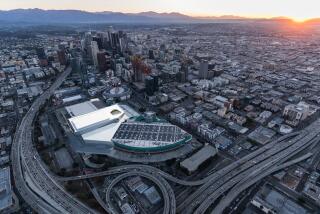Tax to Pay for Palmdale Recreation Center Gets Council’s Tentative OK : Sports: The $25-million, 100,000-square-foot complex would cost the average homeowner $40 to $60 annually.
- Share via
After two years of discussions, the Palmdale City Council has tentatively approved plans to levy a citywide tax to build a $25-million indoor recreation center long sought by residents.
The council voted 5 to 0 Thursday night to pursue funding for the nearly 100,000-square-foot center through a tax that would cost homeowners an estimated $40 to $60 a year. Owners of all other types of property, including apartments and commercial buildings, also would be taxed at varying rates.
Several dozen residents wearing “Rec Center Now” T-shirts turned out to support the long-discussed project, but no one spoke against it or the tax. City officials said they hope to vote on the tax next year and possibly start building in 1993.
Currently, the city has few indoor recreational facilities, despite the summer and winter climate extremes of the high desert. The recreation center project has been widely supported by the city’s many young families who say it will help keep their children occupied and out of trouble.
“We really feel there’s an urgency,” said Cindy Selsor, a leader of the Palmdale Arts and Recreation Center (PARC) Committee, the private group that has been pushing for the project. “We really believe the majority of the community supports this.”
City officials are looking to build the center on about six acres near City Hall. As proposed, the center would include a gymnasium with three courts, an indoor pool and ice-skating rink, four handball courts and training, fitness and activity rooms.
They are proposing to levy the tax through a citywide benefit assessment district that could be approved by the City Council without voter approval. The council Thursday decided against an alternative plan to levy a utility users tax to pay for the center.
Benefit assessment districts, in which the levies appear on property owners’ tax bills, traditionally have been used to fund sidewalk, landscaping and lighting projects. But state law also permits their use for recreation projects, although that has been relatively rare.
City officials said they view the assessment district approach as an advantage because more traditional financing methods typically require the elusive two-thirds approval of voters. Under the city’s plan, residents would pay the tax for 20 to 30 years to pay off bonds issued to finance construction of the center.
Plans call for the council to give final approval to the tax sometime next year after an environmental impact report is prepared for the project. The city also may have to buy the land for the center, depending on where it is ultimately located. The exact details of the proposed tax have not yet been settled. But a city consultant has suggested annual levies of $40 per house, $20 per apartment, 5 cents per square foot on commercial or industrial buildings, and one-tenth of a cent per square foot on undeveloped land.
More to Read
Sign up for Essential California
The most important California stories and recommendations in your inbox every morning.
You may occasionally receive promotional content from the Los Angeles Times.










